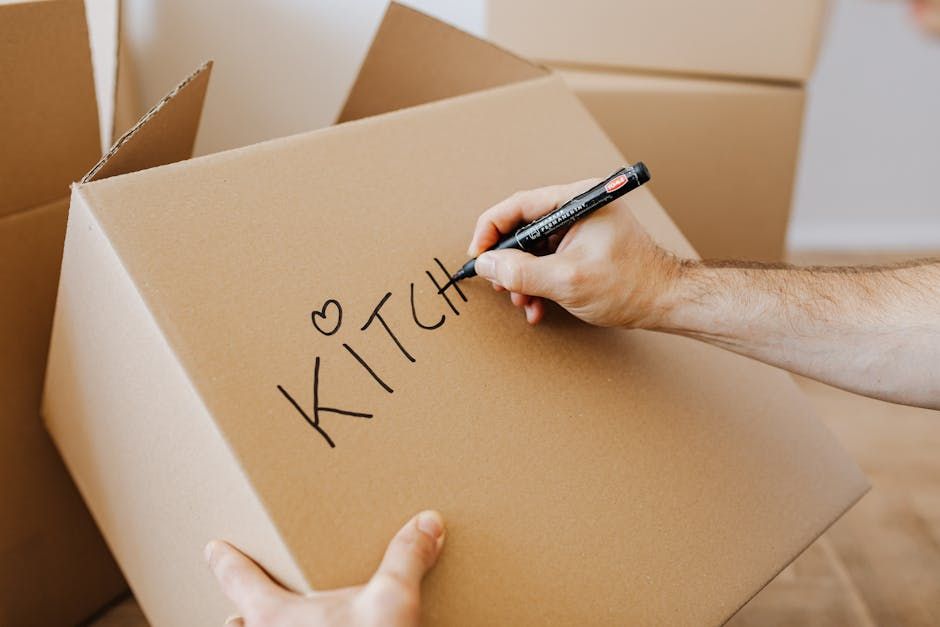How to organize for a move
Moving is one of life's biggest stressors, but it doesn't have to be chaos. Follow our step-by-step guide to plan for a smooth and organized move

It’s a universally acknowledged truth that moving is chaos. Studies have consistently ranked the stress of relocating higher than a job interview or even a dental procedure. The sheer volume of tasks, decisions, and deadlines can feel like a tidal wave.
But it doesn't have to be that way. With a clear strategy, you can impose order on the chaos and manage your move with confidence.
Think of this as your strategic plan to trade stress for structure. Breaking the process down into logical, manageable steps helps you take control of your move from start to finish.
2 / 10
Start with a moving command center

Photo By: Kaboompics.com via Pexels
Before a single box gets packed, the first step is to create a command center. That might sound official, but it’s really just a dedicated, clutter-free zone where all your moving-related information and supplies live. It’s a simple act that creates a physical anchor in the storm, so you’re not scrambling for a pen or a phone number at a critical moment.
Your command center should include:
- A binder or folder for all contracts, receipts, and important documents
- Basic supplies, such as markers, labels, packing tape, and scissors
- A notebook or digital document for to-do lists and notes
3 / 10
Create a moving checklist and timeline
A well-thought-out timeline turns a huge project into a simple to-do list. Start about eight weeks before your moving day. Use this early time to research movers and declutter your home. At the four-week mark, aim to book your truck and start packing up rooms and items you use less. Save the final week for packing up the important bits, confirming all your plans, and notifying utility companies about the switch.
Use a notebook or dedicated app to track everything. The main goal is to prioritize your tasks each week so the process doesn’t snowball into a mammoth task. For a more detailed schedule, a week-by-week moving checklist is a huge help.
4 / 10
Assign roles (if you’re not moving alone)
Moving with a partner, family, or roommates? Don't try to read each other's minds. Miscommunication between family members is a major source of stress, but it’s easily avoided by delegating tasks right from the start.
Hold a brief pre-move meeting to review the timeline and assign clear responsibilities. One person could be in charge of researching, booking, and communicating with movers, while another handles utilities at the old and new places. A shared digital to-do list keeps everyone on the same page and stops important tasks from falling through the cracks.
5 / 10
Declutter before you pack
Every item you get rid of now is one less thing you have to pack, carry, take upstairs, and unpack later. Decluttering saves you time, money, and energy. Be ruthless. If you haven’t used it in a year, it’s time to let it go.
Go room by room to avoid feeling overwhelmed. Create four distinct piles: keep, sell, donate, and toss. You might even host a garage sale to say a final goodbye to the local area while selling items you no longer need.
6 / 10
Gather supplies and pack strategically
Smart packing is a process, not a last-minute panic. Weeks before you move, gather your supplies: sturdy boxes, quality packing tape, markers, and padding. Start by packing the items you use the least, such as seasonal decorations or books from the guest room, so you can make real progress without disrupting your daily life.
A great hack is to use your own towels and linens as free padding for fragile items. Clearly label each box with its destination room and contents. Finally, pack an essentials box with everything you’ll need on day one — chargers, toiletries, basic cooking supplies, and your coffee maker — and make sure it’s the last thing loaded.
7 / 10
Color code and label like a pro
Good labeling is a gift to your future self. The most effective method is assigning a different color of packing tape or sticker to each room. Label every box on the top and at least two sides with its destination room and a brief description of its contents.
For extra credit, number each box and keep a corresponding inventory list on your phone or in your moving binder so you know immediately if a box is missing.
8 / 10
Notify the right people and update information
The administrative side of moving is dull but super important. Forgetting to update your address with the right institutions can lead to missed bills and major headaches down the road. Make a comprehensive list of every service and person you need to notify in the new city you’re moving to, as well as your current location.
Key places you’ll need to contact include:
- The postal service — to forward your mail
- Banks, credit card companies, and loan providers — to update your billing address
- Your employer’s HR department — for payroll and benefits updates
- Utility companies — electricity, water, gas, internet, and trash services
- Subscription services and online retailers — to ensure deliveries reach your new address
- Schools and health care providers — to update records and transfer services
9 / 10
Confirm the details and prepare for moving day
You’re in the home stretch. The week before the move is all about confirming logistics and tying up loose ends to eliminate any last-minute surprises. If you’ve hired movers, call to confirm the date, time, and any other details. If you're renting a truck, double-check your reservation.
Now is also the time to pack a separate bag with your valuables and personal documents that will travel with you personally instead of in the moving truck. Finish disassembling furniture, take down curtains, and do a final clean of your old home or confirm your scheduled cleaning service.
10 / 10
Bonus tips for a smooth move
A few extra hacks can make a world of difference on the big day. These are the small things that separate a chaotic move from a calm, controlled one.
- Photograph your electronic setups. Before you unplug your TV or computer, snap a quick photo of the cord setup. It will make reconnecting everything far easier.
- Use suitcases for heavy items. Your rolling luggage is perfect for moving heavy things like books, canned goods, or tools.
- Rent wardrobe boxes. For a small extra cost, these tall boxes with built-in bars let you move clothes on their hangers, saving time on both ends of the move.
- Prepare a moving day cooler. Pack it with water and easy-to-eat snacks. Moving is a workout, and nobody makes good decisions when they're hungry or dehydrated.
- Defrost your freezer 48 hours in advance. Don't get caught with a last-minute watery mess. Plan to empty, defrost, and clean your fridge and freezer ahead of time.
- Locate your new home's vitals immediately. On your first walk-through, find the circuit breaker box and the main water shutoff valve so you know where they are in case of an emergency.
